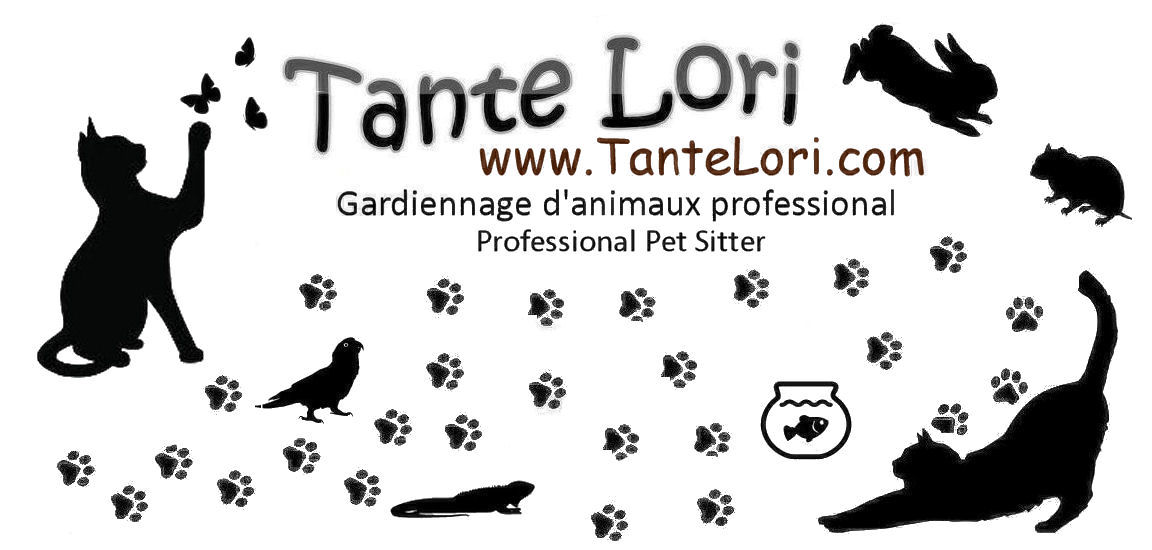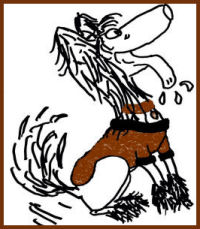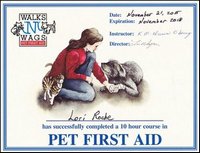2013 TRAINING TIPS by....

Daniel Sterl
Spécialiste en comportement canin / Dog Behaviour Specialist
www.UnHommeEtDesChiens.com
(819) 328-5027
(Français & English)
septembre 2013
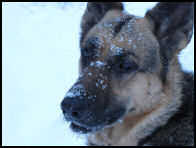
My Name is Daniel Sterl and I’m a dog behaviour specialist. I help dog owners to resolve bad behaviour problems theircompanions may have develop. I use positive reinforcement methods only, which means I’ll never hurt a dog using physical punishment. This is very important as I will explain in the next newsletter.
I do this work because animals, but mainly dogs, are my passion! I soon realized in my life that we, as humans, often struggle to be understood by our best friends and I’ve always wondered why.As a dog behaviour specialist, I’ve learned dog’s language and its primary motivations, With that knowledge, I’m able to adjust my language to its level, as I strongly believe it’s our duty as dog owners to adjust to their level of language, not the opposite! It is with that in mind that I will write to you every month in this newsletter to help you being understood from your dog, so you can become your dog’s best friend.
Daniel Sterl
Punishment can do more harm than good.
Remember when it was regular to punish children with a belt or spank? Thanks to the psychologists who taught us that not only does it hurt physically, but that it also often leaves psychological sequels that require years of therapy to fix.
This is why I help people fix behavior problems with their best friends. This requires therapy for the dog (no worries: it wont take years!) and mostly teaching the owners new ways of training and communicating with their favourite animal.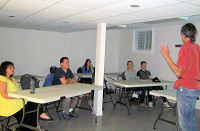
Let’s talk concrete: Imagine a man walking with a puppy on the street. They cross with a couple with a young boy. The dog is happy to see the child and wants to play with him. His way of expressing his joy is to jump on the child. The owner then pulls the leash and chokes him with the choker the dog has around the neck. The dog then stops jumping on the child because he is not strong enough to keep pulling. Next time they meet a child, the dog doesn’t remember and does it again… so does the owner. And the story repeats until Rex remembers the consequence of jumping and wants to avoid the punishment.
But, what really happens in Rex’s head? He makes the association: “a child hurts!” Does Rex like children then? Of course not! The puppy, which first just wanted to play and loved children, now abhors them. Then comes the possibility to have a reactive dog with aggressive behavior towards children.
Next time, I’ll explain what dogs really want in life, and how to use this to our advantage when training them… not to jump on children (or even adult) for example! Have a great month,
Daniel Sterl
.............(Français)................
Vous rappelez-vous l’époque où il était normal de punir les enfants avec une ceinture et la fessée? Merci aux psychologues qui nous ont alors appris que non seulement cela peut blesser physiquement l’enfant, mais aussi que les séquelles psychologiques peuvent être très grandes et prendre des années de thérapies à réparer.
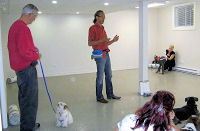 C’est pourquoi j’aide les gens à régler les problèmes de comportement de leurs meilleurs amis. Cela nécessite une thérapie pour le chien (heureusement, ça ne prendra pas des années) et surtout enseigner au propri-ami de nouvelles méthodes d’entrainement et de communication avec leur animal favori.
C’est pourquoi j’aide les gens à régler les problèmes de comportement de leurs meilleurs amis. Cela nécessite une thérapie pour le chien (heureusement, ça ne prendra pas des années) et surtout enseigner au propri-ami de nouvelles méthodes d’entrainement et de communication avec leur animal favori.
Parlons concrètement: Imaginez un homme marchant avec un chiot sur la rue. Ils croisent un couple avec un jeune garçon. Le chien est content de voir l’enfant et veut jouer avec. Pour exprimer sa joie et se faire comprendre, il saute sur le petit homme. Le propriétaire du chien tire alors sur la laisse et punit le chien avec l’étrangleur (choker) que l’animal porte à son cou. Le chien arrête alors de tirer car il n’est pas assez fort… La prochaine fois qu’ils rencontrent un enfant sur la rue, le chien ne se souvient pas et refais le comportement indésirable… tout comme le maître. Et l’histoire se répète jsuqu’à ce que Rex se souvienne de la conséquence de son geste et veuille alors éviter la punition.
Mais que s’est-il vraiment passé dans la tête de Rex? Il a fait le lien suivant : « un enfant, ça fait mal! » Est-ce que Rex aime alors les enfants? Bien sûr que non! Le chiot qui d’abord était joueur et aimait les enfants, les hait maintenant. Vient alors le risque d’avoir un chien réactif ayant des comportements agressifs envers les enfants.
Nous verrons la prochaine fois ce qui motive réellement le chien et comment utiliser cela à notre avantage lorsqu’on l’entrainera… à ne pas sauter sur les enfants par exemple! À bientôt!
Daniel Sterl
 What does your dog want in life?
What does your dog want in life?
If you know this, you’ll have an extraordinary relationship with your companion.
- Are you ready for the biggest secret about dogs?
- Are you ready to discover “what you always wanted to know about dogs but never dared to ask?
So here it is… it’s so simple: what your dog wants is… TO HAVE FUN!
Let’s talk about an example I brought up last month. You want to teach you dog “not to jump on children”. Why does he jump on the kid in the first place? Because he wants to play! Because children are FUN!
How can you teach him not to do so? By making “not to jump on children” even MORE FUN! I’ll use treats, a kid to jump on, and a leash to train him. The treats must be so good that he’ll want to have the treat more than wanting to jump (or at least as much!). Treats have to be attractive… which means FUN in his head!
Instructions: If I make the distance between the dog and the child longer than the leash, he will not be able to jump on the kid, so it’s not going to be as much fun to jump. Which in turn will make the treat even more attractive because he can have it for “NOT jumping”. I simply reward the “NOT jumping” and ignore him when he TRIES to jump on the kid.
You can apply this principle to anything you DON’T want your dog to do.
But you need to figure out what it is that you DO want him to do instead. Try it and HAVE FUN with your best friend!
Que veut donc votre chien dans la vie?
Si vous connaissez la réponse à cette question, vous pourrez avoir une relation extraordinaire avec votre compagnon.
- Êtes-vous prêt pour le secret le mieux gardé des chiens?
- Êtes-vous prêt à découvrir ce que vous avez toujours voulu savoir à propos des chiens sans jamais oser le demander?...
Donc, voilà… c’est pourtant si simple me direz-vous : ce que veut votre chien c’est… AVOIR DU PLAISIR!
Prenons l’exemple dont j’ai parlé le mois passé : apprendre à votre chien à « ne pas sauter sur les enfants ». Pourquoi saute-t-il sur les enfants en premier lieu? Parce qu’il veut jouer! Parce que les enfants sont pour lui synonymes de PLAISIR!
Comment donc lui apprendre à ne pas sauter? En faisant en sorte que « NE PAS sauter soit encore plus PLAISANT » Pour l’entrainer, j’aurai besoin de récompenses, d’une laisse et d’un enfant sur qui sauter. Les récompenses doivent être meilleures que son envie de sauter (ou au moins autant!). Les récompenses doivent être attirantes, ce qui égale PLAISIR dans sa tête.
Ensuite, je fais en sorte que la distance entre l’enfant et le chien soit plus grande que la longueur de la laisse afin qu’il ne puisse sauter dessus. Donc sauter sur l’enfant ne sera plus aussi plaisant! Ce qui en retour rendra la récompense encore plus attirante puisqu’il y aura droit uniquement s’il NE SAUTE PAS dessus. Je récompense simplement lorsqu’il NE SAUTE PAS et je l’ignore quand il ESSAIE de sauter sur le jeune.
Vous pouvez appliquer cette méthode pour tout ce que vous NE voulez PAS que votre chien fasse.
Mais vous aurez besoin de déterminer ce que vous désirez qu’il FASSE à la place! Essayez et ayez du PLAISIR avec votre meilleur ami!
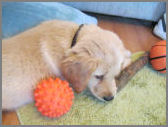 A Puppy for Christmas? How to housetrain.
A Puppy for Christmas? How to housetrain. 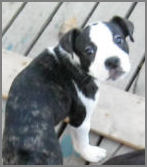
The Holiday season is knocking at our doors, once again! And with it, we want to give to the ones we love… Why not a puppy for your kids you may think?
But then, how will you train the newcomer so he is house trained?
Here are the rules you should follow, so you put all the chances on your side to succeed:
- NEVER leave your puppy free in the house without supervision. How could you do this? Simply attach a leash to your belt and the other end to your dog! That way, when he/she starts smelling the floor and turning into circles (you know the giggle they usually do just before they do their thing?!), you can react quickly. Also, I recommend that you have a crate for the times you’re not home and when you’re sleeping. Dogs are clean animals and they will be much more likely to hold it ‘til they’re taken out of the crate. I also understand that some people may feel using a crate is inhuman; however when used appropriately, the dog will to the contrary feel much safer and at home in his/her “little house”.
- Interrupt him/her if he/she does pee or poo. With joy, say: “Come on” and bring your friend straight outside! DO NOT be angry: remember he/she is learning; give your dog a chance to behave right!
- Always go with him outside until he/she learns: Yes, I know! Having a dog comes with some duties and responsibilities which are not always fun!
- Puppies can’t hold it for a long time. Go out on a regular basis more often until he/she can hold it for a longer time.
- Praise him when he/she is doing his/her thing. And make it sound like he/she did it right for the first time: it’s party time! You’ve never been so happy of your life!!! ;-)
- Never, never, never… punish your dog for doing it inside! Even if you catch him/her while doing it, he/she will not understand why you’re angry at him/her. I cannot emphasize this enough! Punishing your dog WILL stress him/her and create confusion and ultimately he/she will regress in his/her training!
- Train him/her to ask for the door… That is a whole other article on this matter only! Maybe next time?
Have a great Holiday Season! And remember: have fun with your furry friend!
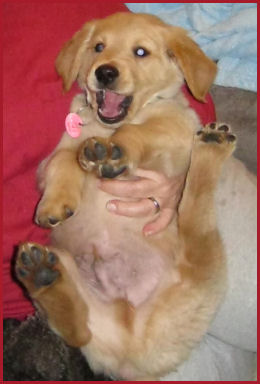 Un chiot pour noël? Comment l’entrainer à la propreté!
Un chiot pour noël? Comment l’entrainer à la propreté!
La saison des fêtes est à nos portes, une fois encore!
Et avec elle, vient le temps de donner et partager avec ceux que nous aimons… Pourquoi pas un chiot pour les enfants pensez-vous?!
D’accord, mais comment entrainerez-vous le nouveau venu à être propre?
Voici les règles de base que vous devriez suivre, afin de mettre toutes les chances de votre côté pour réussir rapidement :
- NE JAMAIS laisser votre chiot libre dans la maison sans surveillance. Comment faire? Simplement attacher une laisse à votre ceinture et l’autre bout de la laisse à votre chien! De cette manière, vous pourrez réagir rapidement lorsqu’il commencera à renifler le sol et à tourner en rond (vous savez, le manège qu’il fait habituellement juste avant de faire ce qu’il doit faire?!!): interrompez-le en l’emmenant à l’extérieur à l’endroit prévu sans tarder. Et restez joyeux : ne vous impatientez pas et ne vous fâchez pas! Je vous recommande également, si ce n’est pas déjà fait, de vous équiper d’une cage pour les fois où vous n’êtes pas à la maison et lorsque vous dormez. Les chiens sont des animaux propres et ils auront donc tendance à apprendre à se retenir jusqu’à ce qu’ils soient sortis de la cage. Je comprends aussi que certaines personnes pensent qu’il est inhumain de mettre un chien en cage. Ma réponse courte est qu’au contraire, lorsque la cage est introduite et utilisée adéquatement, le chien se sentira plus en sécurité et « chez lui » dans sa « petite maison ».
- Interrompez-le s’il est en train de se soulager dans la maison. Avec joie et bonne humeur, dites : « Viens dehors!) et emmenez-le directement à l’extérieur à l’endroit prévu! NE vous fâchez PAS : rappelez-vous qu’il est en apprentissage; donnez lui une chance d’apprendre le bon comportement!
- Accompagnez toujours votre chien à l’extérieur jusqu’à ce qu’il ait appris. Oui, je sais! Avoir un chien vient aussi avec des tâches et responsabilités qui ne sont pas toujours agréables… particulièrement à ce temps-ci de l’année.
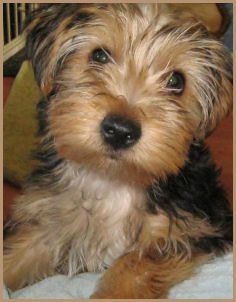
- Prévoyez sortir avec votre chiot plus souvent au début. Un chiot ne peut se retenir très longtemps. Ça peut signifier des sorties aux 2 heures durant le jour et même la nuit au tout début! Avec la cage, parce qu’il bougera moins, vous aurez plus de chances qu’il apprenne rapidement à se retenir plus longtemps. Progressivement, espacez les sorties-pipi/caca de plus en plus. Rapidement vous pourrez enfin faire des nuits complètes!
- Félicitez-le lorsqu’il fait sa besogne. Et faites en une fête comme si c’était la première fois qu’il le faisait comme il faut au bon endroit… à chaque fois! Yahoo!!! C’est le party! Bon chien!!! Vous n’avez jamais été aussi heureux de votre vie! ;-)
- NE JAMAIS, JAMAIS, JAMAIS… punir votre chien pour avoir fait ça à l’intérieur (ou n’importe-où où vous ne voulez pas qu’il le fasse)! Même lorsque vous l’attrapez sur le fait, il ne comprendra pas pourquoi vous êtes fâché(e) après lui. Je ne peux jamais insister sur ce point suffisamment! Punir votre chien le stressera, et le rendra confus (pour ne pas dire anxieux), À TOUT COUP! Et ultimement il pourrait régresser dans son entrainement!
- Entrainez-le à demander la porte… Je pourrais vous écrire un article complet sur ce sujet seulement! Peut-être une prochaine fois?
Pour en savoir plus, notez que j’offre un cours d’obéissance de base dès le 8 janvier. Allez voir le post plus bas sur ma page FB ou contactez-moi pour plus d’informations!
Entretemps, passez un Heureux temps des fêtes! Et rappelez-vous : amusez-vous avec votre meilleur ami à 4 pattes!
